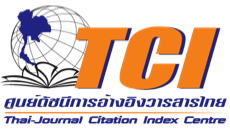การพัฒนากระบวนทัศน์การเรียนรู้ BTU เพื่อส่งเสริม Metacognition ของนักศึกษาบัณฑิตศึกษา สาขาวิชาชีพครู (A Development of BTU Learning Paradigm to Enhance Metacognition of Graduate Students in the Teaching Profession)
คำสำคัญ:
กระบวนทัศน์การเรียนรู้/ อภิปัญญาบทคัดย่อ
วัตถุประสงค์ของวิจัยเพื่อ 1)พัฒนากระบวนทัศน์การเรียนรู้ BTU Model เพื่อส่งเสริม Meta Cognition ของนักศึกษาบัณฑิตศึกษา สาขาวิชาชีพครู 2)เปรียบเทียบความรู้ การวิจัยเพื่อการพัฒนาหลักสูตรและการสอน ก่อนและหลังการจัดการเรียนรู้ตามกระบวนทัศน์การเรียนรู้ BTU Model 3) เพื่อสอบถามความคิดเห็นของนักศึกษาเกี่ยวกับกระบวนทัศน์การเรียนรู้ BTU Model กลุ่มตัวอย่าง ได้แก่ นักศึกษาปริญญาโท สาวิชาหลักสูตรและการสอน ปีการศึกษา 2561 จำนวน 26คน ได้มาโดยสุ่มอย่างง่าย เครื่องมือวิจัยคือแบบทดสอบ แบบสอบถาม วิเคราะห์ข้อมูลโดยการวิเคราะห์ค่าความถี่ ค่าร้อยละ และการทดสอบค่าที (t-test dependent sample)ผลการวิจัยพบว่า
- กระบวนทัศน์การเรียนรู้ BTU Model เพื่อส่งเสริม Meta Cognition ของนักศึกษาบัณฑิตศึกษา สาขาวิชาชีพครูประกอบด้วย 3 ขั้นตอนดังนี้1) B (Begin with the end)การเริ่มต้นด้วยการตั้งเป้าหมาย 2) T (Teaching to learn, Learning to Teach) การเรียนการสอนเพื่อเรียนรู้ เรียนรู้เพื่อจัดการเรียนการสอน นำแผนการเรียนรู้ไปปฏิบัติและ 3) U (Understanding Became Even Deeping)การทำความเข้าใจยิ่งลึกซึ้งยิ่งขึ้นการประเมินและกำกับติดตามมีความถูกต้องแม่นยำ
2 ผลการเปรียบเทียบความรู้รายวิชาการวิจัยเพื่อการพัฒนาหลักสูตรและการสอน ก่อนและหลังการจัดการเรียนรู้ตามกระบวนทัศน์การเรียนรู้ BTU Model พบว่าคะแนนเฉลี่ยหลังเรียนสูงกว่าคะแนนเฉลี่ยก่อนเรียนอย่างมีนัยสำคัญทางสถิติที่ระดับ.01
- นักศึกษามีความคิดเห็นต่อกระบวนทัศน์การเรียนรู้ BTU Modelเพื่อส่งเสริม Meta Cognition ของนักศึกษาบัณฑิตศึกษา สาขาวิชาชีพครูเห็นด้วยในระดับมากทุกข้อ
เอกสารอ้างอิง
Best, J. W. (1977). Research in Education. 3rd ed. Englewood Cliffs, New Jersey : Prentice Hall, Inc
Campbell, D T and Stanley, J. C.(1963).Experimental and Quasi-Experimental Designs for Research Boston : Houghton Mifflin Company.
Christopher Klopper and Steve drew.(2015).Teaching for Learning and Learning for Teaching : Peer Review of Teaching in Higher Education Sense PublishersNetherlands.
Edward L. Pizzini, Daniel P. Shepardson&Sandra K. Abell•.(1989).“A rationale for and the development of a problem solving model of instruction in science education”.Science Education 73 (5):523-534.
Joyce, B and Weil, M. (2009).Model of Teaching London : Allyn and Bacon.
Marzano, R. J. (2000). Designing a New Taxonomy of Educational Objectives. ThousandOaks, CA : Corwin Press.
______. (2007).The Arts and Science of Teaching : A Comprehensive Framework forEffective Instruction. Alexandria. VA : Association for Supervision and CurriculumDevelopment.
Papatsaranon, N.(2018).“The Development 0f DRU Model to enhancingMeta cognition for
Teaching Professional StudentsResearch”.Dhonburi Rajabhat University Journal12 (1):
92 –109.(in Thai)
Stephen R. Covey .(1989).The 7 Habits of Highly Effective PeopleNew York : Simon &
Schuster.
Uamcharoen, S; Lowriendee, W and Mongkol, P. (2016)."The Development of Constructivist Learning Model for the Student Teachers".Silpakorn Educational Research Journal8(1) :28-46. (in Thai)





